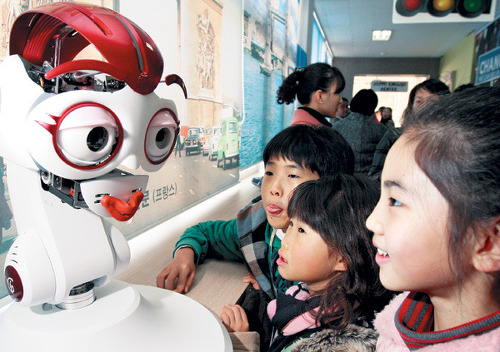The theme of the Paris Motors Show 2010 was “eco-friendly.” Eco-friendly has now become such a preval!ent trend worldwide, especially with the EU’s reinforcement of regulations regarding carbon emissions control
Eco-friendly vehicle invented by KAIST
The Online Electric Vehicle (dubbed OLEV) manufactured by the Korea Advanced Institute of Technology (KAIST) was included in the 50 Best Inventions of 2010 published by The Times, along with Apple’s iPad, Google’s Driverless Car, Sony’s Alpha A55 Camera and others. Also included was the English-Teaching Robot invented by the Korea Institute of Science and Technology (KIST).

In the OLEV are embedded electric power strips that provide electromagnetic power to the vehicle, wirelessly, charging an onboard battery and powering the bus’s electric motor.
The Times introduced the OLEV as an advanced green growth technology that could speed up the commercialization of electric cars and also as the world’s one and only online electric vehicle.
The system’s creators at the KAIST say, “The technology not only eliminates pollution, but also alleviates the problems usually associated with hybrid vehicles such as heavy batteries, lengthy charging and limited range.”
Korean technology opens up a new horizon
The OLEV has been on a test operation since last March at the Seoul Amusement Park. It was also presented during the G20 Seoul Summit in November in front of COEX, garnering outstanding reviews. Furthermore, the vehicle is scheduled to be featured next month in the TV program “Into the Future” of Discovery channel.
The OLEV received mixed reviews in the early stage of its development. Although it is an innovative technology that was meant to pursue both green growth and economic profit, some voiced the car’s low practicality as the cost of planting electric power strips under the pavements would be quite steep. Nonetheless, its inclusion in The Times list is without a doubt a distinct acknowledgement of its potential.
The English-Teaching Robot
The other Korean item that made in the Times list is the English-Teaching Robot nick-named “Mero,” developed by the Korea Institute of Science and Technology (KIST).

The robots can move in any direction and can follow human facial expression!s. They are not only effective teachers, but the students also enjoy interacting with their new, fun, and cool school “staff.”
While the robots are used primarily in support roles for real human teachers, the Time Magazine called them a “job terminator,” saying they could potentially replace the native speakers currently employed in Korean schools.
Although there remain issues of economic feasibility as well as ethics, both inventions indicate excellent capacity of Korean universities as future leaders of world science and technology.
Source: http://blog.naver.com/korea_brand/10099191717


